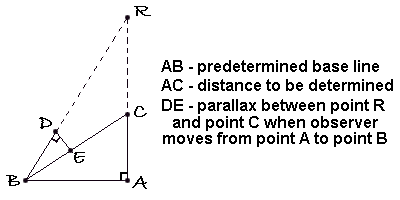<font color="black"><h1><b><center><u>Measuring Large Distances</u></center></b>
Purpose:
To measure large distances using parallax
Theory:Parallax: the apparent shift in position of 1 object with respect to a second object when the observer changes his point of view.
 If the reference point R is established sufficiently distant compared to point C, then the lines of sight ACR and BDR will be very nearly parallel. When AR is parallel to BR, then BDE will be similar to ABC.
If the reference point R is established sufficiently distant compared to point C, then the lines of sight ACR and BDR will be very nearly parallel. When AR is parallel to BR, then BDE will be similar to ABC.
Procedure:Select a position where you can see something way off in the distance (point R). Make sure you (point A), the object (point C), and the point way off in the distance are in a straight line. To do this..use the view finder to make sure you are in a straight line.
After doing that mark off a base line (AB) of 3 meters for Trial 1 and 8 meters for Trial 2. Make sure the base line is at a 90 degree angle to line AR.
From point B you then sight the finder at the reference point. Note that the object is now off the line of sight. Measure how far off the line of sight it is, and record that number in your data table.
Then do your second trial with an 8 meter base line, and record how far off the object is.
Then using the relationship discussed under the theory section of this lab determine the unknown distance AC.
Now measure the distance from point A to point C using a meter stick and put that number in your data chart, and find the percent error.
Data:
| |
AB |
DB |
DE |
AC (calc) |
AC (known) |
%difference and %error |
Trial 1 |
3 meters |
0.46 meters |
0.085 meters |
16 meters |
16 meters |
0% |
Trial 2 |
8 meters |
0.46 meters |
0.19 meters |
19 meters |
16 meters |
19% |
Calculations:AC/AB=BD/DE
AC 0.46m AC 0.046m
3m = 0.085m = 16m 8m = 0.19m = 19m
16m - 16m 19m - 16m
16m x 100 = 0% error 16m x 100 = 19% error
Results:In Trial #1 we were very successful and somehow managed to get 0% error. But in Trial #2 we didn't do quite as good and got 19% error. This is a little strange because trial #2 had a larger baseline and therefore should have ended up being more accurate. They're are several places where this major error of calculation may have occured. Most likely it was an error in measurement when we were measuring how far away the chair (point C) was from our point A. The longer distance to measure made it more likely to have error. Another factor that might have caused the 19% error was perhaps improper use of the finder. Just a slight difference in the site may have caused a large error.
Conclusion: I think we were successful in this lab even though we had a large percentage error for Trial #2. This is only our first lab and we now have an idea of what to expect in future labs...and how to make more precise measurements.
FOR A MORE DETAILED VIEW OF MY LAB BOOK GO TO
https://www.angelfire.com/al/KiKn2/physics.html
